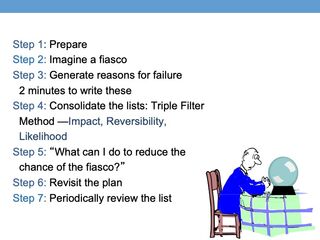Leadership
The Pre-Mortem Method
A practical way to do risk assessment.
Posted January 14, 2021 Reviewed by Ekua Hagan
I developed the pre-mortem method 30 years ago, to help my company cut down on problems when we performed projects. We had no grand ambitions for the method. And yet, over the decades the pre-mortem method has kept getting more popular. It is used in corporate boardrooms, in wildland firefighting operations, in Army programs, and on Wall Street. Nobel laureates—Danny Kahneman and Richard Thaler—have encouraged people to use it. The pre-mortem’s appeal is that it is a risk assessment method that works.
Method. The pre-mortem is simple to run, and can take as little as 20-30 minutes. If you conduct the pre-mortem in a kickoff meeting, with the team sitting around a table, the members have become familiar with the plan. Then you tell them that you are switching gears. You pretend you are looking into an imaginary, infallible crystal ball and—oh no! The plan you’ve just discussed has turned out to be a failure. A fiasco. That much is certain.
Next, you ask each team member to take two minutes to write down the reasons why the plan failed.
Once the two minutes are up you go around the room, asking each person to announce his/her top reason. Then on to the next person for an item that is different. You write their issues on a whiteboard, giving each person a chance to talk. You start with the team leader, to set an example of being candid.

At the end, you have a list of showstoppers. The project leader and the team is now sensitized to things that can go wrong (Klein, 2007).
In contrast, the usual kickoff meeting might not even ask people to describe any concerns. Or the leader might ask, “Anyone see any problems?” There is silent pressure in these meetings not to surface doubts that might disturb the team’s harmony. Team members might not even be able to think of any major problems.
The pre-mortem reverses this dynamic—people show how smart they are by the quality of the issues that they raise. The crystal ball has shown a definite failure and this changes everyone’s mindset. Now your team members are drawing on their experience to imagine how this failure occurred.
Does it work?
Evaluation. Veinott, Klein, and Wiggins (2010) compared the pre-mortem to other methods. We used 178 college students and posed a hypothetical situation in which a major epidemic was sweeping the country—an outbreak of H1N1 flu. (We were 10 years ahead of our time, showing the accuracy of our own crystal ball.) In this scenario, the university administrators had developed a plan for keeping the students safe while continuing operations and the students had to critique that plan. Results: The students in the pre-mortem condition showed the greatest reduction in (over)confidence, compared to simple critiques, or generating pros and cons.
Mistakes. Paul Sonkin and Paul Johnson and I have identified some common mistakes people make in running a pre-mortem: Asking the non-challenging question, “What can go wrong?” instead of using the crystal ball to affirm that the plan has been a disaster. Or allowing the team members to describe their items at a slow, leisurely pace rather than rapidly surveying them and keeping the energy high. Or letting one person, usually a senior team member, dominate the session by going through all the items on his/her list rather than taking turns going around the room.
Improvements. We’ve also made some changes over the years. To reduce discouragement, we now have the team look at the problem list and then take another two minutes for each member to identify actions s/he can take to address some of the items. Another change, that Marcus Dimbleby and I recently introduced, is to have the members assess each of the problems for likelihood, impact, and ease of prevention.
Benefits. The pre-mortem method has a number of benefits besides identifying trouble spots in a plan, reducing overconfidence and promoting discoveries. The method can strengthen members’ mental models as they hear from others. It can deepen the appreciation the team members have for each other as they hear ideas they hadn’t thought of themselves. And it can help create a culture of candor and trust.
References
Klein, G. (2007). Performing a project premortem. Harvard Business Review, 85(9), 18-19.
Veinott, E. S., Klein, G., & Wiggins, S. (2010). Evaluating the effectiveness of the PreMortem technique on plan confidence. Proceedings of ISCRAM, Seattle, WA.


